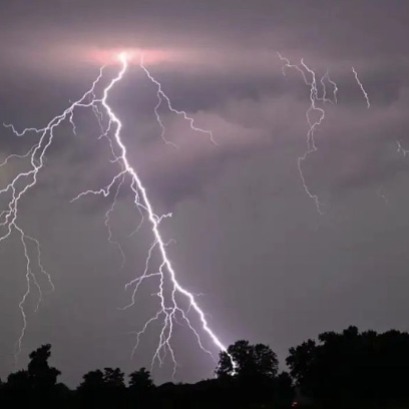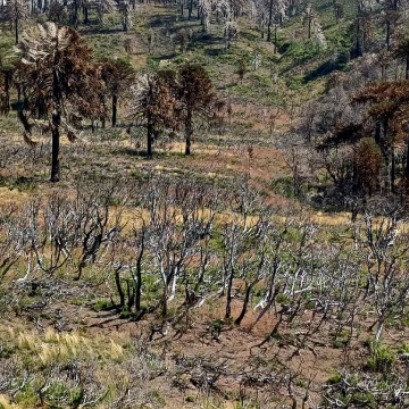
320 million trees die every year due to ray fall
Researchers from the Technical University of Munich (TUM) have developed new calculation models that, for the first time, estimate the global influence of rays in forest ecosystems.
According to its findings, published in Global Change Biology, it is estimated that 320 million trees die each year due to the fall of rays.Tree losses caused by forest fires caused directly by rays are not included in these figures. In the future, the mortality of light -induced trees could increase due to the increase in the frequency of flashes.Damage caused by rays in forests are usually difficult to detect and have only been systematically studied in a few places. Until now, it was not known with certainty how many trees die every year around the world due to direct damage to rays. The TUM research team has developed the first method to estimate how many trees are so severely affected by rays that finally die. Its conclusion: the ecological impact of the rays has underestimated.While the previous studies focused on field observations in individual forests, TUM researchers adopted a mathematical approach. They expanded a widely used global vegetation model by integrating observational data and global patterns of rays.Now we can not only estimate how many trees die annually by rays, but also to identify the most affected regions and evaluate the implications for global carbon storage and forest structure, explains in a statement Andreas Krause, principal author of the study and researcher of the chair of interactions Earth-Atmosphere surface.The 320 million victims every year of the rays represent between 2.1 % and 2.9 % of the total annual plant biomass loss. It is estimated that this biomass decomposition issues between 770 and 1,090 million tons of CO2 per year.The researchers emphasize that these emissions are surprisingly high: their magnitude is comparable to that of approximately 1,260 million tons of CO2 that are released annually due to the combustion of live plants in forest fires. However, total CO2 emissions of forest fires are substantially higher (around 5,850 million tons per year), since they also include the burning of dead wood and organic matter of the soil. More in the futureThe 320 million victims every year of the rays represent between 2.1 % and 2.9 % of the total annual plant biomass loss. It is estimated that this biomass decomposition issues between 770 and 1,090 million tons of CO2 per year.The researchers emphasize that these emissions are surprisingly high: their magnitude is comparable to that of approximately 1,260 million tons of CO2 that are released annually due to the combustion of live plants in forest fires. However, total CO2 emissions of forest fires are substantially higher (around 5,850 million tons per year), since they also include the burning of dead wood and organic matter of the soil. Most climatic models project an increase in rays frequency in the coming decades, so it is convenient to pay more attention to this disturbance, largely ignored, says Krause.Currently, the mortality of ray -induced trees is greater in tropical regions. However, the models suggest that the ray frequency will increase mainly in the regions of medium and high latitudes, which means that ray mortality could also charge greater relevance in temperate and boreal forests.
IT MAY INTEREST YOU
 Missions | New illegal felling in the Piņalito Provincial Park in San Pedro reveals the silent expansion of deforestation in protected areas
Missions | New illegal felling in the Piņalito Provincial Park in San Pedro reveals the silent expansion of deforestation in protected areas
The advance of deforestation on protected areas was once again evident this week in the Piņalito Sur Provincial Park, in San Pedro, where the Ministry of Ecology and Renewable Natural Resources confirmed a new case of selective illegal logging. The event occurs in a context of growing concern about the fragility of the environmental control system in rural and border areas, where the scarcity of resources, personnel and logistics limits the capacity of surveillance against criminal organizations organized to steal native woods and market them on the black market in connivance with sawmill owners.
 Specialists from 10 provinces develop forest landscape restoration strategies throughout the country
Specialists from 10 provinces develop forest landscape restoration strategies throughout the country
The program is developed by researchers from INTA, Conicet and the Argentine Wildlife Foundation.
 They promote research in pine resins from the NEA
They promote research in pine resins from the NEA
The forestry industry is one of the most important sectors in the economies of Misiones and Corrientes. Thousands of hectares of pine supply the paper, pulp, boards and sawmill industry. Pinus elliottii, one of the species established in the region, in addition to providing wood, is used to produce resin, a non-wood forest product with high demand in the chemical, pharmaceutical and cosmetic industries. In 2\024, resin extraction of approximately 52,6\0\0 tons was achieved from approximately 18,\0\0\0,\0\0\0 trees in production, generating income and jobs with high expansion potential.





















